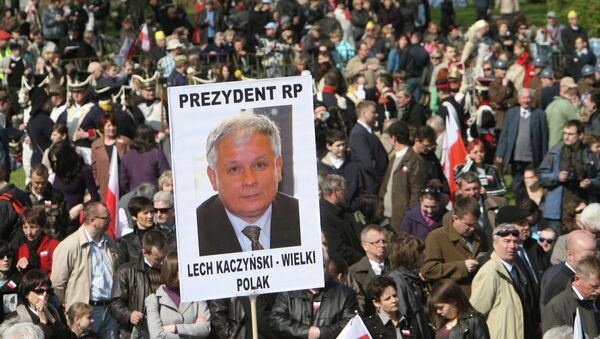MOSCOW (Sputnik) – The aircraft was flying below the 100-meter landing minimum and crashed at 10:41 a.m. Moscow time (7:41 GMT), while approaching runway 26 of the Severny Airfield near Smolensk, in foggy weather conditions.
April 12 was designated a day of mourning in Russia after the crash, and Poland declared a week of mourning.
#Poland #news #Smoleńsk — #Komorowski pays respects at tomb of Lech #Kaczyński: http://t.co/9lADp3Htyc pic.twitter.com/SZr4EvrdxF
— Inside Poland (@InsidePoland) 9 апреля 2015
On January 12, 2011, the Inter-State Aviation Committee published its final report on the causes of the April 10, 2010 crash. The Committee explained the crash by using systematic factors, including insufficient flight support and inadequate crew training, rather than by the crew's decision not to land at an alternative airfield. Case materials show that General Andrzej Blasik, Commander of the Polish Air Force, was in the cockpit as the plane approached the airport. Experts concluded that Blasik influenced the pilots' decision to land in Smolensk despite air traffic controller warnings.
On July 29, 2011, the Polish government commission into the crash submitted its own report naming the pilot's tardy decision to execute a go-around as the main reason for the crash. The terrain awareness and warning system (TAWS) was not correctly calibrated before the flight, and the crew made mistakes during the landing approach.
Poland believes that the Russian air traffic controller in Smolensk issued incorrect orders to the crew, and that the airfield infrastructure failed to provide sufficient flight safety, particularly in such factors as poor visibility.
In January 2012, experts from the Krakow-based Jan Sehn Institute of Forensic Research, who had been studying the crashed Tu-154's flight recorder data, submitted their findings. Unlike the experts who had listened to the recordings soon after the disaster, they did not hear the voice of General Blasik. This raised doubts as to his presence in the cockpit, and made irrelevant claims by investigators that he was pressuring the crew. Moreover, the authors of the new expert research concluded that voices heard in the cockpit could have been coming from the main cabin.
On September 10, 2012, a parliamentary committee set up to investigate the cause of the crash, including members of the opposition party Law and Justice, posted its report entitled "28 Months after Smolensk" online. The group put forward its own theory that the plane had crashed as a result of several explosions. The plane crashed during a confrontation between then Polish President and Prime Minister Donald Tusk, the report notes.
The report's authors also blamed the Polish Government for allowing Russia to investigate the crash.
In late October, the newspaper Rzeczpospolita claimed that the aforementioned experts had allegedly found traces of explosives on debris from the plane. The Chief Military Prosecutor's Office investigating the crash refuted these claims.
In early March 2013, Russian and Polish investigators completed another stage of their collaborative work. No signs of an explosion were found.
In April 2013, Polish authorities established another group of experts to prepare an official report on the causes of the tragedy.
On March 27, 2015, the Polish Chief Military Prosecutor's Office indicted two air traffic controllers from Smolensk airport for unintentionally causing the Polish Air Force crash.
On April 7, 2015, the Polish media reported new findings in deciphering the plane's flight data recorders. The new data indicated that General Blasik was in the cockpit and presumably pressuring the crew. Captain Martzin Maksyan from the Polish Chief Military Prosecutor's Office officially confirmed the existence of new and more accurate interpretations of the flight data recordings and stressed that media stories contained many inaccuracies.
Poland wants Russia to transfer what remains of the aircraft to Poland as soon as possible, while the latter insists that they should remain in Russia for the time being, citing the need for possible additional inspections.




